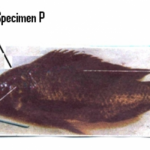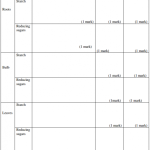KNEC KCSE Past Papers 2019 Biology Paper 3 (231/3)
Kenya Certificate of Secondary Education
2019
Biology Paper 3
BIOLOGY Questions and answers
1. You are provided with specimens F and G. obtained from different plant species.
Observe them together with photographs E and H and answer the questions that follow.
Note: Do not destroy specimens F and G as you will need them for question 2.

(a) (i) State hoow plants represented by specimen F and photographs E and H protect themselves.
(ii) State the likely habitat of each of the plant in (a)(i),giving a reason in each case.
Specimen F (1 mark)
Habitat
——————————————-
Reason
——————————————–
Photograph E (1 mark)
Habitat
——————————————-
Reason
——————————————–
Photograph H (1 mark)
Habitat
——————————————-
Reason
——————————————–
(b) Examine the leaves of specimen G.
(i) Describe two observable features of thèse leaves that help the plant conserve water. (2 marks)
(ii) Besides leaf structure, explain two mechanisms that help the plant in (b) (i) above not to dry up during the dry season. (2 marks)
2.You are provided with specimens labelled J and K in addition to F and G and mid II (used in question I).
(a) Follow the dichotomous key below to identify E, F, G, H, J and K.
(a) Leaf margin smooth ……………………………. GO to 2
(b) Leaf margin serrated/rugged ……………………. GO to 3
2. (a) Leaf parallel-veined ……………………….. K
(b) Leaf net-veined or veins not showing …………….. Go to 4
3. (a) LeaF with thorny edges …………………………H
(b) Leaf edges not thorny ……………………………. Go to 5
4.(a) Leaf Large ……………………………………… G
(b) Leaf Tiny ……………………………………………. E
5. (a) Leaf thorny stern …………………………………. F
(b) Leaf not on stern ……………………………………. G
Fill the table below,indicating the steps used to identify the leaves of each specimen or photograph.
Leaf Steps followed
E ………………………………………….
F ………………………………………….
G …………………………………………..
H ……………………………………………
J ……………………………………………
K …………………………………………………
(b) (i) Besides leaf’features found in the dichotomous key above, state two other features that can be used to identify leaves. (2 marks)
State the complementary characteristics that define the leaf features stated in (b) (i). (2 marks)
(c) The habit of a plant in its environment is referred to as being a tree, shrub or herb, depending on its height.
Suggest the habits of the plants from which specimen F and photograph H were obtained. (2 marks)
3. You are provided with specimens L and M which are types of teeth from the same mammal.
Observe these specimens together with photographs N and P and answer the questions that follow.
(a) (i) With a reason in each case, name the type of tooth represented by specimens L and M
Specimen L
Name ……………………………
Reason ………………………….
Specimen M
Name ……………………………
Reason ………………………….
(ii) Draw and label specimen L.(2 marks)
(lii) State two functional differences between specimens L and M (2 marks)
(b) State the diet of the mammals from which photographs N and P below wera obtained. giving a reason in each case.

(i) Photograph N (2 marks)
Diet ………………………………………
Reason ……………………………………
(i) Photograph P (2 marks)
Diet ………………………………………
Reason ……………………………………
Name the joint labelled K on photograph P. (1 mark)
(ii) Explain two features of the joint named in (c) (i) above that makes it adapt to its function. (2 marks)







